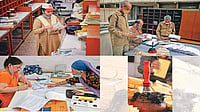It was the direst season thus far—death bared its fangs from every corner, and the grim reaper went about its macabre business with ruthless efficiency. Many of us confronted mortality in ways that will have singed us for long and went through near-death experiences in the months of April and May this year, during the deathly second wave of COVID-19. Most lived in absolute terror, hearing and reading about the random madness of fatalities across the country. Some feared a final reckoning, an Armageddon; others wondered if Lord Shiva had descended from Mount Kailash to perform his tandav dance as a destroyer of the world. People died randomly, chaotically, irrationally and inexplicably—at homes, on the streets, in cars, and in hospital parking lots and receptions.
But all of us, with rare exceptions, experienced another form of dread over the past 16 months—a gut-wrenching decimation, bit by inexorable bit, of our financial securities. Our incomes and savings were hollowed out, then annihilated. We lived, and continue to exist, in times of economic panic, as we tremblingly await the portended coming of the third wave later this year. The pandemic hacked at our economic security. While the virus ate away at lungs and other organs, it ravenously gnawed away at our money too.
ALSO READ: Bound To A Sinking Boat
This is not the tale of how the Indian economy, like others across the globe, was disrupted by waves of fiscal tornadoes that ruined businesses. This is the untold story of how personal finances suffered across socio-economic sections, blithely and brutally disrespecting class or urban-rural biases. That virulent and relentless viral attack changed our lifestyles, whether we were kings or paupers. It made us do unexpected and unprecedented things.
Social media—that modern barometer of gauging the universal through the minutiae of the personal—is awash with shocking messages. In his LinkedIn post, Ratnesh Thakur narrated how his 25-year-old business shut down, wife died and family survived on loans. “I am open for a job or any work which (can) put bread on my table. I have three dependents…my kids and my old mother,” reads his distressed text. Similarly, Puja lost her job at a beauty parlour, worked as a maid and was unemployed again during the second wave. She needed Rs 1,00,000 to treat her mother.

School tennis coach Mahesh Chaudhary of Delhi, who is deaf and mute, does not have an income after classes became online due to Covid restrictions; G. Krishna Reddy runs a home-delivery service for villagers in Andhra Pradesh—a startup that has caught on with the rural folk because of the pandemic.
Outlook spoke to dozens of people from different socio-economic backgrounds. The desperation was palpable. Nisar Ahmad Mattu, 40, has rowed his shikara in Srinagar’s Dal lake for two decades. His livelihood disappeared. These days, he either goes on his boat alone, or spends a few hours talking to fellow shikara-wallahs. “My wife insists I find another job, but I am not fit for any other work. My biggest problem is to pay the children’s school fees,” he mutters.
ALSO READ: Covid Rebranded Our Lifestyle
Life is at a standstill for Mahesh Chaudhary, 39, a deaf and mute tennis coach. The former pigeon seller coached 20 kids at Delhi’s ASN School. When the schools closed last April, his monthly income of Rs 30,000 stopped. So did the rents from the rooms that his family let out, as tenants left. His neighbour Sukhdev says Mahesh sold off his beloved pigeons too. Now, he is a forlorn man who waits for schools, and tennis courts, to open.

Incomes Extinguished
A CMIE survey found that 97 per cent of Indian households witnessed a dip in real incomes, adjusted for inflation, in the past 12 months. The remaining three per cent included either the super rich or the wretched poor. “The former have sources that deliver incomes even during lockdowns, and the really poor ones do not have scope for further fall,” says Mahesh Vyas, the think tank’s MD & CEO. Households that earned over Rs 20 lakh a year faced the “least pains”.
ALSO READ: Why We Feel Poorer?
Though job losses most certainly contributed to the income implosion, this is not the main reason. Unemployment rate, found the CMIE survey, peaked in April 2020 to more than 20 per cent, and slumped to around 6-7 per cent in March this year. Vyas feels that while most jobs came back, earnings did not. “In January 2021, total household incomes were 5.3 per cent lower than what they were a year ago. But jobs were 2.4 per cent lower. Evidently, earnings fell much more than jobs,” he says.
Over the past months, people have begged and borrowed to survive. First, they dipped deep into their bank accounts and investments. Bilal Ahmad Pathoo, a houseboat owner in Srinagar, took a loan. So did 54-year-old Akshita Arora, a Mumbai-based actor, whose three children, too, were out of work. She also used up her savings and sold off jewellery to make ends meet. Narinder Singh, who worked at the Indian Coffee House in Shimla, dunked into his PF (Rs 47,000) and LIC (Rs 10,000).
Luckily, communities and social groups did their mite to mitigate the misery. Theatre and film actor Joyraj Bhattacharjee played a crucial role in managing the Priyonath Manna Bastee kitchen in West Bengal’s Howrah district. The underprivileged get free meals and others pay Rs 20 each. Each day, 400 people depend on the kitchen, which started in March 2020. Joyraj, along with other actors, raised funds for it through online concerts.
However, Joyraj, whose community kitchen completed 300 days on June 11, 2021, is poorer than he was, not finding professional work since April 2020. “As of today, I will not go hungry. I don’t know what will happen if this goes on for a few more months. Other passionate and dedicated actors and technicians don’t have the resources to wait. Talented professionals, like sound and light engineers, took up unrelated work,” he explains sorrowfully.
Wealth Inequalities
Experts contend that although most families were affected by income diminution, inequality between the haves and have-nots has widened. CMIE data showed that while 99.3 per cent of Indian homes that earned less than Rs 1 lakh a year were impacted, the losses upset only 77.6 per cent of those who took home more than Rs 10 lakh. More than a fifth of the rich not only managed to protect their incomes, but witnessed an increase in their overall wealth.
A little less than two-thirds—60 per cent—of India’s “ultra-wealthy” saw an increase in their individual wealth in 2020, says Shishir Baijal, CMD, Knight Frank India. He adds that 91 per cent of them expect their net worth to rise further in 2021. At present, the number of ultra high net worth individuals in India is 6,884, along with 113 dollar-billionaires, as per the Knight Frank Wealth Report (2021). The figure is expected to go up by 63 per cent between 2020 and 2025.
Hurun Global Rich List (2021) found that India rose to the third spot in the world with 177 dollar-billionaires, i.e. 40 more than last year. Of them, 150 became richer than what they were, and included 50 new faces. The wealth of the patriarchs of business houses such as Mukesh Ambani, Gautam Adani, Shiv Nadar, Kumar Mangalam Birla, Pankaj Munjal and others went northwards during the pandemic. Mumbai was home to 61 dollar-billionaires, followed by Delhi (40).
In a bizarre manner, this is reflected in stock valuations, backed by corporate profits. Stock indices bounced back since March 2020, and are now higher than their earlier peaks. A few shares boomed by 10 times or more in the past 15 months. Due to huge setbacks to businesses, combined corporate revenues slumped in 2020-21 compared to the previous two years, but operational profits (before interest and tax) zipped up. Profits were in the black zone for the first time in three years; they were in the negative territory in 2018-19 and 2019-20.
Net direct tax revenues—corporate and individual taxes—between April 1 and June 15 this year were an “astounding” 100 per cent more than the figure for the same period in 2020. GST continued to be robust; it topped over Rs 1 trillion a month for the past eight months. On an overall basis, explains D.K. Srivastava, chief policy advisor, EY India, “The higher tax collection is largely due to higher excise duty on petroleum products. The government has not reduced its taxes on them.”
How does one explain this scenario? Thanks to the lockdowns and recession, corporate revenues were down in the dumps. However, profits went up due to huge reductions in costs (under heads like manpower and marketing). Firms that survived and thrived (healthcare and e-commerce) paid higher taxes. More profits translated into spurts in stock valuations, which accelerated due to diversion of money from government stimulus packages into equities.
This is a global trend. The inequality virus, stated a 2021 Oxfam report, afflicts a majority of nations. A survey of 295 economists in 79 nations found that a majority of them were convinced that the Covid crisis would lead to high inequalities in terms of incomes, wealth and gender. For example, 87 per cent expected that “income inequality in their country was either going to increase or strongly increase as a result of the pandemic”.
Thrifty Spenders
In November 2020, when Narinder, an employee of Shimla’s Indian Coffee House, went to his hometown in Uttarakhand, he was stressed. After being unpaid for months, he had no idea how he would meet his kids’ desires for gifts, shopping and eating out. His wife handled the grim situation, and told the children not to make unreasonable demands. In fact, his daughter bought him a new mobile. “She said, ‘Papa, you have sacrificed a lot for us’,” he remembers with tears in his eyes.
Most scaled down expenses and lifestyles, both by default (lockdowns) and due to financial crunch. Mohammad Parvez, a brass welder in Moradabad, whose income dwindled to a trickle, confesses that Eid was a low-key affair, and that he didn’t have the money to buy new clothes. Many shifted to smaller cities to cut down expenses. “My spouse and I shifted to my parents’ house, and we took our son out of pre-nursery school,” says a professional who journeyed from Delhi to Goa.

She lost her papa to Covid this April—her life now at a crossroads, Mahi, a student of class 6, sells shirts that her 45-year-old tailor-father and his helpers made at home on four sewing machines. She lays out the shirts on a bench on a street in Khirni Bagh of UP’s Shahjahanpur, calls out for customers, and remembers the ice-cream and pastries her father brought her. The thoughts keep her going as she fends for the family: her mother and ailing grandparents.
Even some of the rich weren’t spared. Anurag Katriar, or AK, who owns Indigo Hospitality and operated well-known F&B brands, agrees that he and his family had to slash personal expenses like online orders. To keep his son’s spirits high, AK plays the chef at home, and cooks chicken and potatoes with the child. Large purchases are out, and he has postponed plans to buy a new car. Manish Rathi, co-founder and CEO of IntrCity RailYatri, admits that everyone in the company took salary cuts initially. While salaries were restored for most employees, this wasn’t the case with the top management. “The two huge personal things I planned for last year—my lavish 50th birthday party and a vacation to Europe—were deferred due to lockdowns and curbs on global travel,” he says. The family wants the situation to be normal before it ventures out.
As per the RBI’s annual report (2021), private consumption, at negative 9 per cent in 2020-21, “registered a contraction for the first time in the past four decades”. Government consumption sagged, and dropped from 7.9 per cent in 2019-20 to 2.9 per cent in 2020-21. Estimates released by the NSO in February 2021 indicated that “aggregate demand, measured by real GDP, contracted by 8 per cent in 2020-21. This is the first contraction experienced since 1980-81, and the severest ever”.
However, it seems surprising and contrarian that 50.6 per cent of the respondents in RBI’s May 2021 round of Consumer Confidence Survey said their overall spending went up. A higher 60.5 per cent felt expenditure would be higher a year from now. This can be explained by two factors—a rise in general inflation and prices, and the difference between what the consumers spend on essential items (food, fuel and education) and non-essential ones (travel and entertainment).
Over the past year, despite Covid and lockdowns, or due to them, inflation raised its ugly head. In 2020-21, inflation, stated RBI’s annual report, was the highest since 2013-14, and it was largely fuelled by the price rise in the food and beverages component. Vegetable oil prices soared over the past year or so. A litre of mustard oil costs 50 per cent more in Delhi today, compared to its price in May last year. The same is true for fuels; petrol is more expensive than beer in certain cities.
Almost two-thirds of the respondents in the central bank’s survey felt their expenses on essential items shot up in May 2021, and a higher 68 per cent thought this would be the case next year. The figures were the opposite for non-essentials. Nearly 60 per cent said their spending reduced this May, and a lower 37 per cent expected it to come down next year. It was a double-whammy for us—we spent more on what we couldn’t avoid, and we curbed our desires.
Suspended Savers
Chaos and confusion prevailed with regard to our savings and investments. Indians were confronted with emergencies (health and income losses), fears of possible medical crises at home, and social pressures to help friends and relatives in need. So, we put our hands in the piggy banks—FDs, PFs, insurance, and assets like jewelry and stocks—and simultaneously beefed up the money pile at our disposal. We withdrew money, and tried to save whenever possible.
Ask anyone, and she has a financial story to narrate. A colleague said he took cash out of his pension account to pay his kids’ college fees. A friend broke her FDs when her husband lost his job. People sold stocks and mutual funds to remain in cash, and purchased them back when the markets recovered. Many had to pay annual medical and insurance premiums. In some cases, the alternative was to take on debts. Only a few lucky ones managed to get help from family and friends.
“Savings were affected in a differential manner,” says CARE Ratings chief economist Madan Sabnavis. “Households spent more on health in the past few months and would have less ability to spend on discretionary items. Further, as people can’t spend, they have to save, either in cash or financial instruments. With high cumulative inflation and low returns on deposits, there is a temptation to move into stocks and mutual funds. But the question remains: how many are reaping its benefits?”
When some tried to sell assets to restore financial stability, they found themselves in a bind. The jewellers or the gold loan entities forced them to sell the ornaments, rather than take loans against them. This meant they parted ways with the necklaces, rings and bracelets that were passed on over generations. In the real estate market, buyers asked for massive discounts as sellers were under pressure. So was the case with those who wished to sell their vehicles to raise cash.
While complete data is missing, a few clues are available. As per RBI’s annual report, household savings showed an “upsurge” to 21 per cent of GDP in the first quarter (April-June) of 2020-21. This was due to “COVID-19 led reduction in discretionary expenditure and the associated surge in precautionary saving despite stagnant/reduced income”. The rate dropped to 10.4 per cent of GDP in Q2 (July-September) 2020-21 as people “switched from ‘essential only’ spending to discretionary spending with gradual reopening/unlocking of the economy”.
Clearly, we Indians were tossed around like feathers during the breeze, and reacted to events. The crisis threatened to engulf anybody and everybody. While our personal finances were on top of our minds, emergencies buffeted and heaved us in different directions. Our carefully built boats seemed incapable of weathering the storm. The waves, two till now and more to come, loom over us.
Postscript: Three months ago, G. Krishna Reddy began a proof of concept for his third start-up—a home-delivery service for villages. Based out of Tadipatri, a small town in Andhra Pradesh, he bootstrapped the new venture, KarryNow, with savings, after two earlier failures. He feels he will be lucky this time, thanks to the pandemic. “Everyone’s focus is rural, and rural logistics is the biggest problem for e-commerce players,” he says. “People are willing to work as delivery boys in rural areas and potential buyers, who worked in tech firms, are back in their villages to cut costs and work from homes.”
(With inputs from Naseer Ganai in Srinagar, Ashwani Sharma in Shimla, Singdhendu Bhattacharya in Calcutta, Ajay Sukumaran in Bangalore, Giridhar Jha, Soumitra Bose and Lachmi Deb Roy)


























